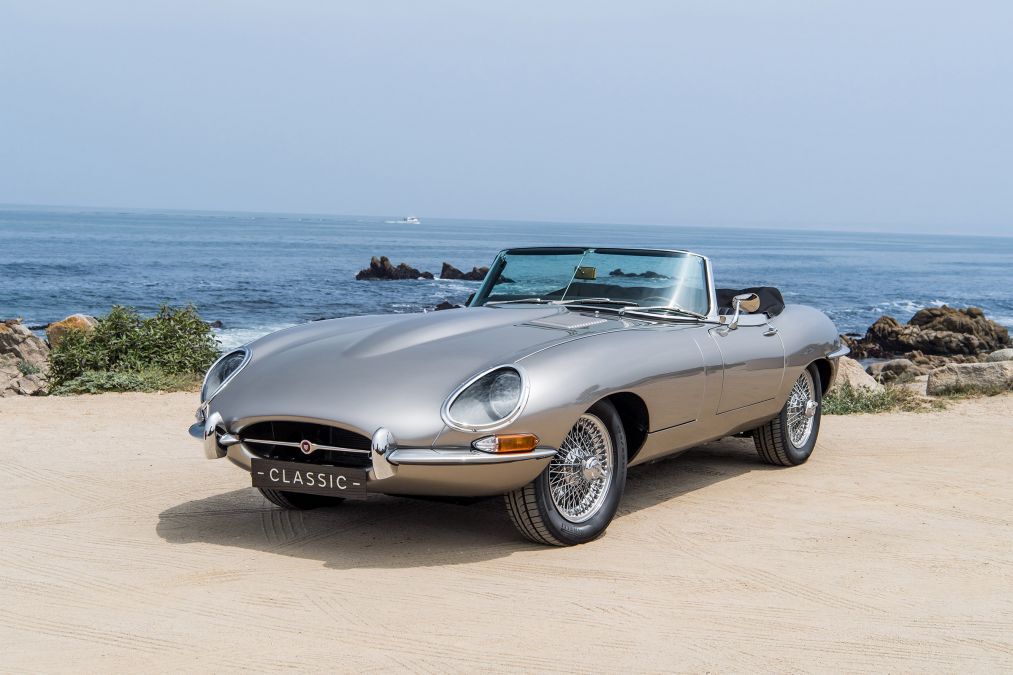Jaguar E-type Zero – Electrified classic
As impressive as the Jaguar I-Pace is, it’s the electric E-type that appeals the most. Anthony Ingram gets behind the wheel of a unique classic, electrified!
 As impressive as the Jaguar I-Pace is, it’s the electric E-type that appeals the most. Anthony Ingram gets behind the wheel of a unique classic, electrified!
As impressive as the Jaguar I-Pace is, it’s the electric E-type that appeals the most. Anthony Ingram gets behind the wheel of a unique classic, electrified!People are staring. Of course they are – I’m driving a Jaguar E-type. Even in Monterey in the middle of Car Week, where scissor doors and velocity stacks outnumber SUVs, an immaculately restored example of one of the world’s most recognisable automotive shapes still turns heads. Those facing away as I approach get a little less time for their eyes to linger, however, as they won’t know I’m there until the silvery-gold flash enters their peripheral vision. That’s because the E-type Zero is electric powered, and unlike even the silkiest of straight-six versions, it’s virtually silent.
You may already be familiar with the E-type Zero, if not the earlier concept from 2017’s TechFest event in London, then as driven by the Duke of Sussex after the royal wedding earlier in the year. Either that or via internet outrage, as spittle-flecked keyboards were mashed in anger that anyone dare meddle with a British institution.
“Overall weight is the same as an original, As is the weight distribution”
Tim Hannig, director of Jaguar Land Rover Classic, has heard it all before. He tells me there were plenty of arguments in-house about electrifying old E-types, and the car’s internal codename was Project Marmite. I’m not sure whether to take seriously his off-the-cuff comment that there were death threats, but we are living in 2018.
A benefit of it being 2018 is that Jaguar now has a production electric vehicle on the road, giving JLR Classic ready access to cutting-edge EV componentry. The Zero takes its motor and drivetrain controllers from the Jaguar I-Pace, and its lithium-ion batteries are shared with plug-in hybrids such as the Range Rover PHEV.
The layout is custom, as you’d expect given the 1960s surroundings, but the integration is spectacularly neat. The 40kWh battery stack is good for a real-world 240 kilometres and sits precisely where the 265bhp XK ‘six’ would in a standard Series 1 E-type. A 295bhp electric motor lies aft of that, and sends its power through a conventional propshaft to the standard differential and half-shafts. The suspension is also standard, as are the wheels, tyres and brakes. As you’d hope given the Zero’s anticipated price tag of around Rs 2.72 crore, customers will be able to upgrade on an individual basis, but Jaguar’s aim was for an authentic driving experience.
Hannig runs through JLR Classic’s five parameters for the car. One: no structural changes; the car needs no new metalwork and can, if a subsequent owner chooses, be returned to standard. Two: no compromise for the operator in terms of space, so none of the components impinge upon driver, passenger or luggage space.
Three: ‘We said we want the same dynamics in terms of performance as the original car,’ says Hannig. ‘You can easily do a “limping” E-type with a 60kW air-cooled motor and it’ll cruise very respectably, but it’s not the performance you would expect.’ Hence 295bhp, 0-100kmph in 5.5sec, and in production form, a genuine 240kmph.
Four (this is the good one): overall weight for the Zero is the same as a fully-fuelled original. As is the weight distribution and centre of gravity. ‘Otherwise it starts to feel odd,’ says Hannig. Jaguar was lucky: the straight-six is a bit of a boat anchor, together with gearbox and fluids coming in at 350kg or so, and this allowed plenty of wiggle room for heavy battery packs. With standard running gear and near-identical weight to an original, the Zero really is similar to drive. And finally, five: that 240km useable range. ‘If it’s much less than that, it’s going to be tricky to accept,’ explains Hannig.
There’s no typical owner profile as yet – Jaguar still isn’t sure how many it’ll sell. There is apparently strong interest from early-adopter types, who otherwise wouldn’t even consider a classic car, and from existing E-type owners looking for the same style but fewer age-related compromises.
Equally, Jaguar sees the Zero approach as a way of future-proofing classics (including, as Hannig confirms, almost any other Jaguar from the late ’40s to the mid-’90s), preserving them and making them suitable for more demanding future generations. And Jaguar won’t be stripping high-value, matching-numbers cars, by the way – conversions will be carried out on the flotsam and jetsam of the E-type market.
Will those future generations enjoy the Zero? Quite possibly; I rather did. Twisting the key and pulling away so easily and silently feels much stranger than in a modern EV, but the push-to-go performance puts you at ease in a way no recalcitrant classic normally does. Yet overall it still feels remarkably, well, old, and stripping away the original’s soundtrack doesn’t neuter the driving experience.
There’s still work to be done on the details, such as accelerator mapping, regenerative braking and some of the interior trim, but all the signs are that by the time the first cars are delivered in 2020 it should be a conversion with plenty going for it. And if all else fails, it’s still an E-type, so it’ll still turn heads.


